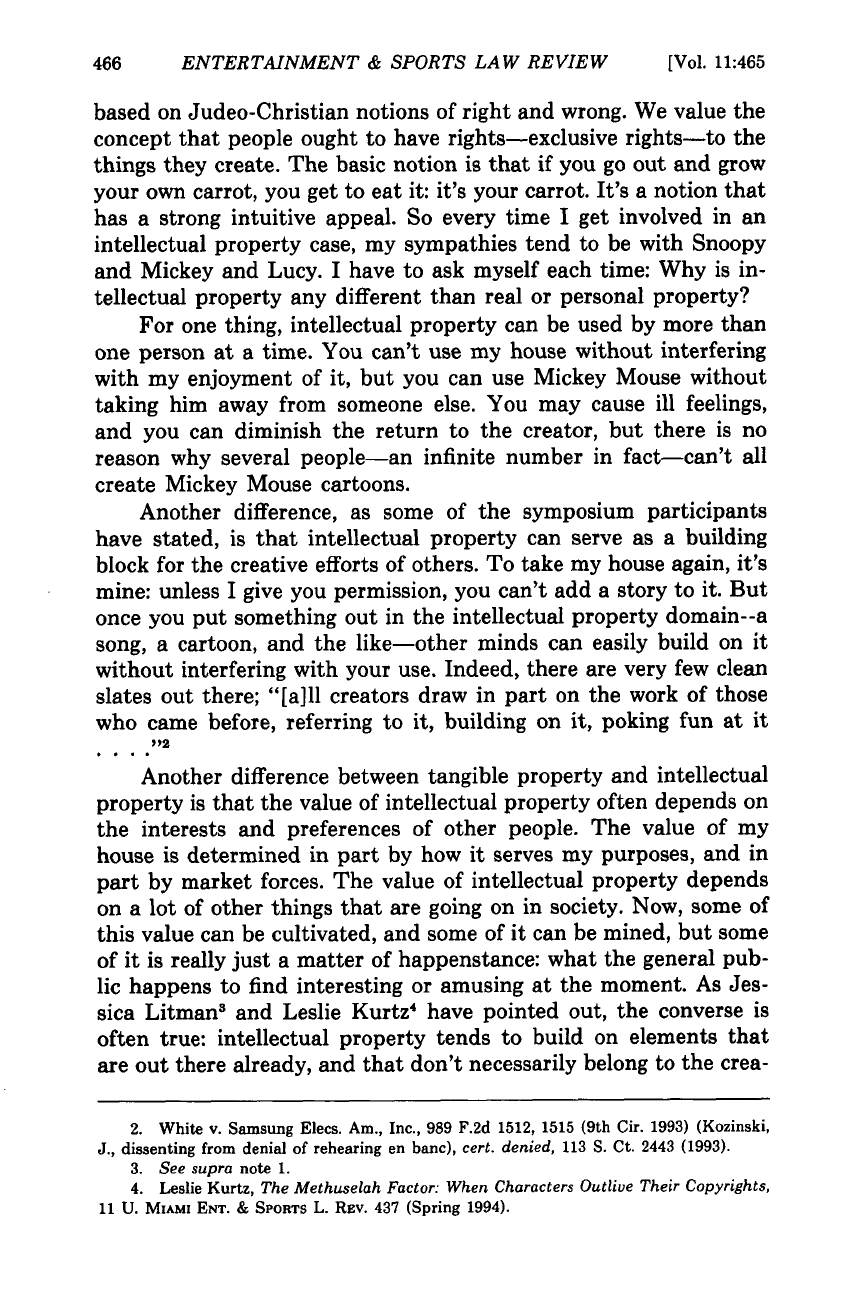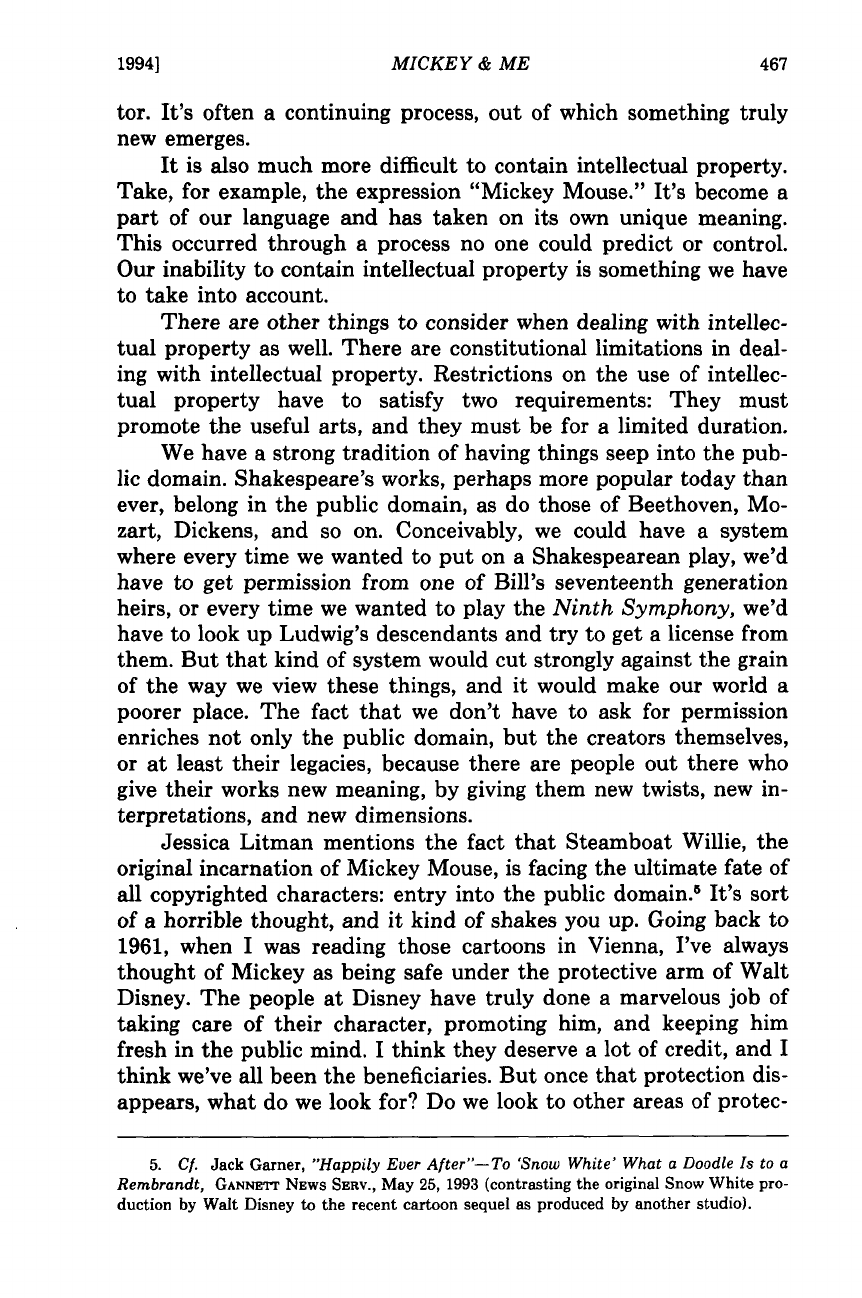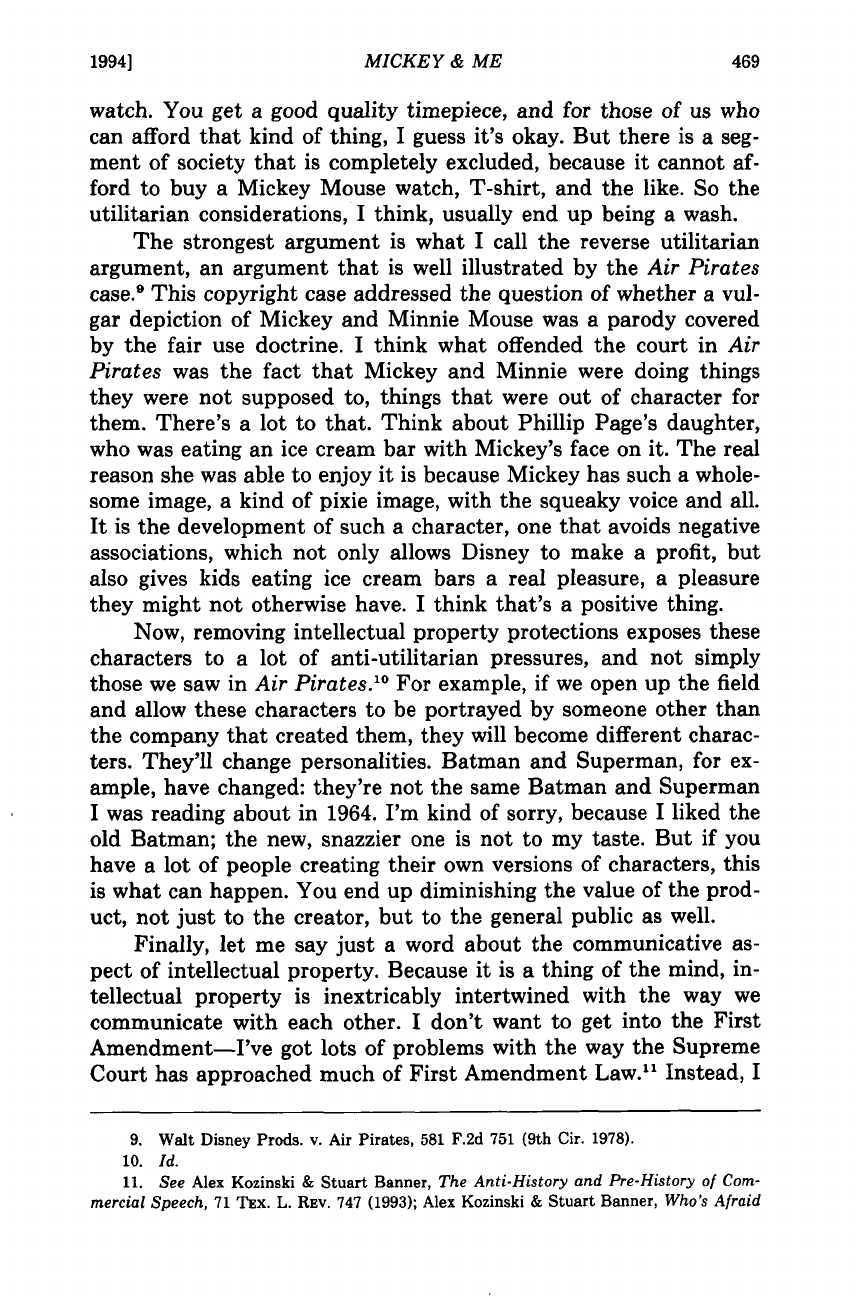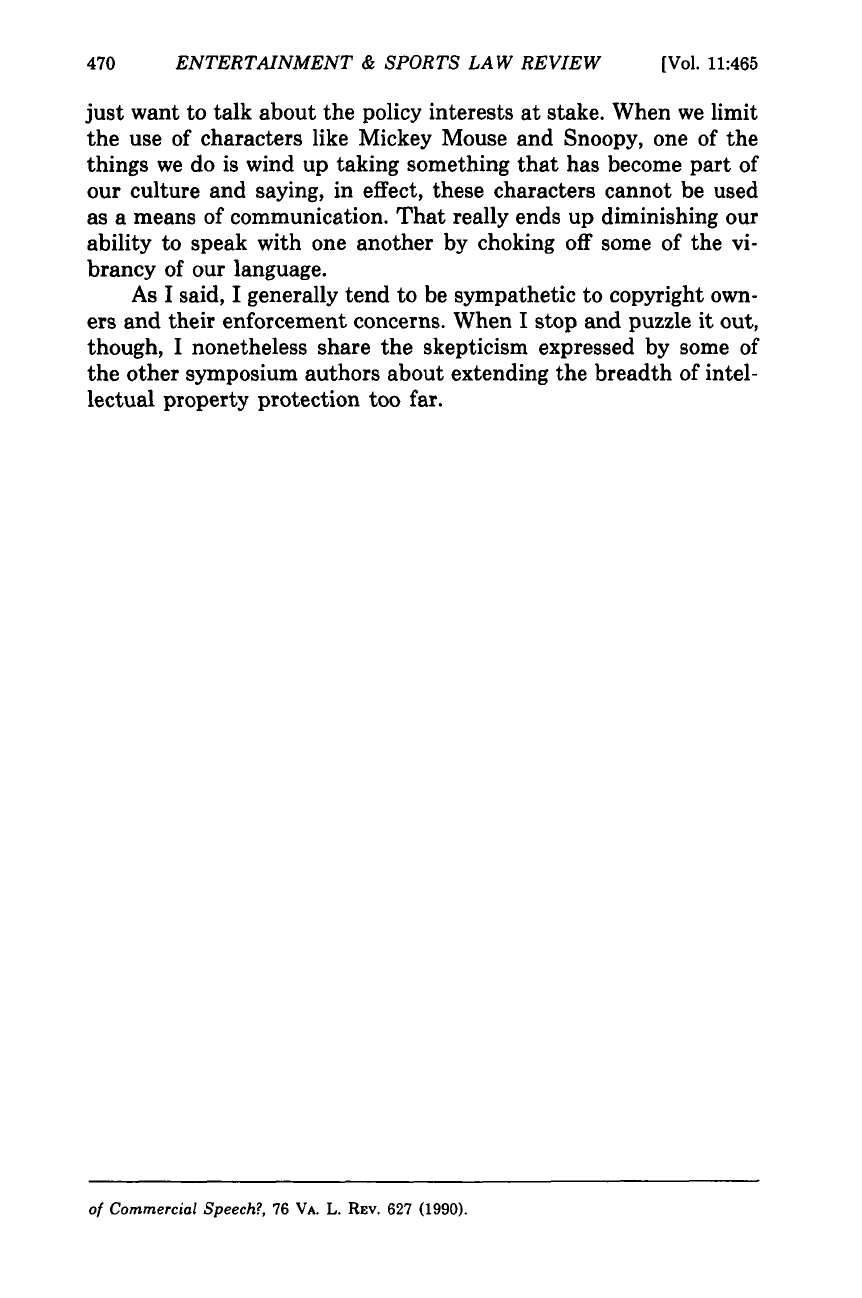
University of Miami Law School
Institutional Repository
*&1"-.&/4+#&)&*/"-/&*)"*/,+-/.2"1&"2
Mickey & Me
Alex Kozinski
+((+2/%&.*!!!&/&+*(2+-'./ %7,-",+.&/+-4(2)&)&"!00)".(-
-/+#/%" -/.*!*/"-/&*)"*/+))+*.*!/%" */"-/&*)"*/*!,+-/.2+))+*.
6&.4),+.&0)&.-+0$%//+4+0#+-#-""*!+,"* "..4*./&/0/&+*(",+.&/+-4/%.""* ",/"!#+-&* (0.&+*&**&1"-.&/4+#
&)&*/"-/&*)"*/,+-/.2"1&"24*0/%+-&5"!!)&*&./-/+-+#*./&/0/&+*(",+.&/+-4+-)+-"&*#+-)/&+*,("." +*/ /
(&--4(2)&)&"!0
" +))"*!"!&//&+*
("3+5&*.'& Mickey & Me &)&*/,+-/."1
1&(("/%7,-",+.&/+-4(2)&)&"!00)".(-1+(&..

MICKEY
& ME
ALEX
KOZINSKI*
Unlike
many
of
the
symposium
participants,
I
don't
consider
myself
an
intellectual
property
expert;
I'm
more
of
a
consumer
of
intellectual
property.
I
do
have some
credentials,
however:
I'm
a
Mickey
Mouse
fan
from
way
back.
I
started
reading
Mickey
Maus
comic
books
in
Vienna
when
I
was
about
eleven.
I
would
go
down
to
a
little
corner
store
and
buy
a
used
comic
book
for
two
shillings.
When
I
was
done
reading
it,
I
would
swap
it
for
the
next
issue,
for
half
a
shilling,
and
rush
home
to
read
the
next
installment
in
Mickey's
adventures.
When
I
came
to
the United States,
I was
very
surprised
to learn
that
Mickey
and
the
gang
all
spoke
English.
It
took
me
many
years
to
figure
it
all
out.
My
credentials
also
include
a
stint
as an enforcer of
intellec-
tual
property
rights.
My
wife
is
a
lawyer,
and
she
used
to
represent
Snoopy.
It's
really
interesting
being
married to
someone
who
en-
forces
intellectual
property
rights:
it
becomes
kind
of an obsession.
I
found
myself
going
into
stores
and
surreptitiously
sneaking
up to
little
white
dogs
with
black
spots
and
checking
under
their
tails,
to
see
whether
they
were
licensed
by
United Features
Syndicate. I
remember
when
we
were in
Las
Vegas
on a
short
vacation,
and
we
passed
by
a
novelty
store
where
there
was
a
T-shirt
with
a
picture
of
Lucy
on
it.
Lucy
wasn't
just
sitting
at
her booth
waiting
to
give
advice,
though;
she
was
clutching
her
protruding
belly
and
saying,
"Damn
you,
Charlie
Brown!"
We
bought
the
T-shirt,
and
lawsuits
followed
soon
thereafter.
These
days
intellectual
property
is
just
one
area
of
law
I
deal
with,
and
every
time
I
get
into
it,
I
have
to
re-think the
principles
involved.
Some
of
our
most
deeply
held
values
and
beliefs
tend
to
push
us
toward
expanding
intellectual
property
rights.
Jessica
Lit-
man
1
mentioned
a
survey
where
93%
of
the
people
agreed
that
you
shouldn't
be
able
to
put
Mickey
Mouse
on
your
product
unless
you're
licensed.
That's
our
natural
reaction;
it
just
seems
right.
It
comes
from,
I
think,
our
appreciation
of
the
value of
private prop-
erty.
We
are
a
capitalist
society,
and
we
have
a
system
of
morality
*
Judge,
U.S.
Court
of
Appeals
for
the
Ninth
Circuit.
1.
Jessica
Litman,
Mickey
Mouse
Emeritus:
Character Protection
and
the
Public
Do-
main,
11
U.
MIAMI
ENT. &
SPORTS
L.
REV.
429
(Spring
1994).
1
Kozinski: Mickey & Me
Published by Institutional Repository, 1994

ENTERTAINMENT
&
SPORTS
LAW
REVIEW
based
on
Judeo-Christian
notions
of
right
and
wrong.
We
value
the
concept
that
people
ought to
have
rights-exclusive
rights-to
the
things
they
create.
The
basic
notion
is
that
if
you
go
out
and
grow
your
own
carrot,
you
get
to
eat
it:
it's
your
carrot.
It's
a
notion
that
has
a
strong
intuitive
appeal.
So
every
time
I
get involved
in
an
intellectual
property
case,
my
sympathies
tend
to
be
with
Snoopy
and
Mickey
and
Lucy.
I
have
to
ask
myself
each
time:
Why
is
in-
tellectual
property
any
different
than
real
or
personal
property?
For
one
thing,
intellectual
property
can
be
used by
more
than
one
person
at
a
time.
You
can't
use my
house
without
interfering
with
my
enjoyment
of
it,
but
you
can use
Mickey
Mouse
without
taking
him
away
from
someone
else.
You
may
cause
ill
feelings,
and
you can
diminish
the
return
to
the
creator,
but
there
is
no
reason
why
several
people-an
infinite
number
in
fact-can't
all
create
Mickey
Mouse
cartoons.
Another
difference,
as
some
of
the
symposium
participants
have
stated,
is
that
intellectual
property
can
serve as
a
building
block
for
the
creative
efforts
of
others.
To
take
my
house
again,
it's
mine: unless
I
give
you
permission,
you
can't
add
a
story
to
it.
But
once
you
put
something
out
in
the
intellectual
property
domain--a
song,
a
cartoon,
and
the
like-other
minds
can
easily
build
on
it
without
interfering
with
your
use.
Indeed,
there
are
very
few
clean
slates
out
there;
"[a]ll
creators
draw
in
part
on
the
work
of
those
who
came
before,
referring
to
it,
building
on
it,
poking
fun
at
it
Another
difference
between
tangible
property
and intellectual
property
is
that
the
value of
intellectual
property
often
depends
on
the
interests
and
preferences
of
other
people.
The
value
of
my
house
is
determined
in
part
by
how
it
serves
my
purposes,
and
in
part
by
market
forces.
The
value
of
intellectual
property
depends
on
a
lot
of
other
things
that
are
going
on
in society.
Now,
some
of
this
value
can
be
cultivated,
and
some
of
it
can
be
mined,
but
some
of
it
is
really
just
a
matter
of
happenstance:
what
the
general
pub-
lic
happens
to
find
interesting
or
amusing
at
the
moment.
As
Jes-
sica
Litman'
and
Leslie
Kurtz
4
have
pointed
out,
the
converse
is
often
true:
intellectual
property
tends
to
build
on
elements
that
are
out
there
already,
and
that
don't
necessarily
belong
to
the
crea-
2.
White
v.
Samsung
Elecs.
Am.,
Inc.,
989
F.2d
1512,
1515
(9th
Cir.
1993)
(Kozinski,
J.,
dissenting
from
denial
of
rehearing
en
banc),
cert.
denied,
113
S.
Ct.
2443
(1993).
3.
See
supra
note
1.
4.
Leslie
Kurtz,
The
Methuselah
Factor:
When
Characters
Outlive
Their
Copyrights,
11
U. MiAMi
ENT.
&
SPORTS
L.
REv.
437
(Spring
1994).
[Vol.
11:465
2
University of Miami Entertainment & Sports Law Review, Vol. 11, Iss. 2 [1994], Art. 10
http://repository.law.miami.edu/umeslr/vol11/iss2/10

MICKEY
&
ME
tor.
It's
often
a
continuing
process,
out
of
which
something
truly
new
emerges.
It
is
also
much
more difficult
to
contain
intellectual
property.
Take,
for
example,
the
expression
"Mickey
Mouse."
It's
become
a
part
of
our
language
and
has
taken
on
its
own
unique
meaning.
This
occurred
through
a
process
no
one
could
predict
or
control.
Our
inability
to
contain
intellectual
property
is
something
we
have
to
take
into
account.
There
are
other
things
to
consider
when
dealing with
intellec-
tual
property
as
well.
There
are
constitutional
limitations
in
deal-
ing
with
intellectual
property.
Restrictions
on
the
use
of
intellec-
tual
property
have
to
satisfy
two
requirements:
They
must
promote
the
useful
arts,
and
they
must
be
for a
limited
duration.
We
have
a
strong
tradition
of
having
things
seep
into
the
pub-
lic
domain.
Shakespeare's
works,
perhaps
more
popular today
than
ever,
belong
in
the
public domain,
as
do
those
of
Beethoven,
Mo-
zart,
Dickens,
and
so
on.
Conceivably,
we
could
have
a
system
where
every
time
we
wanted
to
put
on
a
Shakespearean
play,
we'd
have to
get permission
from
one
of
Bill's
seventeenth
generation
heirs,
or
every
time
we
wanted
to
play
the
Ninth
Symphony,
we'd
have
to
look
up
Ludwig's
descendants
and
try
to
get
a
license from
them.
But
that
kind
of
system
would
cut
strongly
against
the
grain
of
the
way
we
view
these
things,
and
it
would
make our
world
a
poorer
place.
The
fact
that
we
don't
have
to
ask
for
permission
enriches
not
only
the
public
domain,
but
the
creators
themselves,
or
at
least
their
legacies,
because
there
are
people
out
there
who
give
their
works
new
meaning,
by
giving
them
new
twists,
new
in-
terpretations,
and
new
dimensions.
Jessica
Litman
mentions
the
fact
that
Steamboat
Willie,
the
original
incarnation
of
Mickey
Mouse,
is
facing
the
ultimate
fate
of
all
copyrighted
characters:
entry
into
the
public
domain.,
It's
sort
of
a
horrible
thought,
and
it
kind
of
shakes
you
up.
Going
back
to
1961,
when
I
was
reading
those
cartoons
in
Vienna, I've
always
thought
of Mickey
as
being
safe
under
the
protective
arm
of
Walt
Disney.
The
people
at
Disney
have
truly
done
a
marvelous
job
of
taking
care of
their
character,
promoting
him,
and
keeping
him
fresh
in
the
public
mind.
I
think
they
deserve
a
lot
of
credit,
and
I
think
we've
all
been
the
beneficiaries.
But
once
that
protection
dis-
appears, what
do
we
look
for?
Do
we
look
to
other
areas
of
protec-
5.
Cf.
Jack
Garner,
"Happily
Ever
After"-To
'Snow
White'
What
a Doodle
Is
to
a
Rembrandt,
GANN=r
NEWS
SERV.,
May
25,
1993
(contrasting
the
original
Snow
White
pro-
duction
by
Walt
Disney to
the
recent
cartoon
sequel
as
produced
by
another studio).
19941
3
Kozinski: Mickey & Me
Published by Institutional Repository, 1994

468
ENTERTAINMENT
&
SPORTS
LAW
REVIEW
tion,
like
trademark
law?
Trademarks
raise
some
interesting
questions,
because
at
the
core
of
trademark
law
is
the
issue
of
confusion.
Confusion
really
is
an
interesting
question
when
you
deal with
it
in
the
context
of
a
case.
I
had
such
a
case,
in
Plasticolor
Molded
Prods.,
Inc.
v.
Ford
Motor
Co.,
6
dealing
with
Ford
floormats.
The
twist
was,
they
were
made
by
Plasticolor.
I
made
them
change
the
labeling
to
some-
thing
along
the
lines of,
"This
is
not
made
by
Ford.
Now
listen,
this
is
really
not
made
by
Ford.
Trust
us,
this
is
not
made
by
Ford,"
in
big
letters,
over
and
over.
A
consumer
had
to
pick
up
the
tab
that
said
all
this
to
even
see
'Ford'
underneath.
The
funny
thing
was,
later
consumer
surveys
showed
that
about
60%
of
those
responding
said
they
thought
the
mats
were
made
by
Ford.
Go
fig-
ure.
This
is
just
one
example
of
how
consumers
are
not
always
en-
tirely
rational.
We
certainly
do
not
want
people buying
counterfeit
Mickey
Mouse
T-shirts
thinking
they
were
made
by Disney
and
being
deceived.
But
putting
aside
the
question
of
confusion,
what
do
we
look
for?
In
a
recent
article,
7
I
lay
out
some
of
the
policies
we
should
think
about
when
deciding
how
to
protect
trademarks.
It
seems
to
me
there
are
basically four
areas
we
should
look
at:
moral
considerations,
utilitarian
considerations,
what
I call
the
reverse
utilitarian
argument,
and
the
communicative
interest.
Let
me
run
through
each
of
these
briefly.
The
moral
consideration
is
simply
this:
What
have
you
done
that
deserves
protection? With
a
copyrighted
character
that
has
received
the
full
benefit
of
its
copyright,
and
then
loses
that
pro-
tection
upon
expiration,
it
seems
to
me
the
moral
claim
is
pretty
weak.
You
have
struck
a
deal
with
society,
and
the
time
you
were
given
ran
out.
That
should
be
the
end of
it.
Utilitarian
considerations
are
a
little
more
significant,
because
we
know
that
if
you
give
someone
property
rights
in
something,
you avoid
the
tragedy
of
the
commons."
Disney
promotes
its char-
acters
and
protects
them and
that
tends,
according
to
economic
theory,
to
enhance
the
value
of
the
property,
not
only
for
Disney,
but
for
the
rest
of
us
as
well.
But
there
are
considerations
that
cut
the
other
way.
I
once
bought
a
pretty
expensive
Mickey
Mouse
6.
713
F.
Supp.
1329
(C.D.
Cal.
1989).
Unfortunately,
the
decision, along
with
my
words
of
wisdom,
was
vacated,
by
me,
no
less.
767
F. Supp.
1036 (C.D.
Cal.
1991).
7.
Alex
Kozinski,
Trademarks
Unplugged,
68 N.Y.U.
L. Rev.
960
(1993).
8.
See
generally
William M.
Landes
&
Richard
A.
Posner,
An
Economic
Analysis
of
Copyright
Law,
18
J.
LEGAL
STUD.
325 (1989).
[Vol.
11:465
4
University of Miami Entertainment & Sports Law Review, Vol. 11, Iss. 2 [1994], Art. 10
http://repository.law.miami.edu/umeslr/vol11/iss2/10

MICKEY
&
ME
watch.
You
get
a
good
quality
timepiece,
and
for
those
of
us
who
can
afford
that
kind
of
thing,
I
guess
it's
okay.
But
there
is
a
seg-
ment
of
society
that
is
completely
excluded, because
it
cannot
af-
ford
to
buy
a
Mickey Mouse
watch,
T-shirt,
and
the
like.
So
the
utilitarian
considerations,
I
think,
usually
end up
being
a
wash.
The
strongest
argument
is
what
I call
the
reverse
utilitarian
argument,
an
argument
that
is
well
illustrated
by
the
Air
Pirates
case.
9
This
copyright
case
addressed
the
question
of
whether
a
vul-
gar
depiction
of Mickey
and
Minnie
Mouse
was
a
parody
covered
by
the
fair
use
doctrine.
I
think
what
offended
the
court
in
Air
Pirates
was
the
fact
that
Mickey
and
Minnie
were
doing
things
they
were
not
supposed to, things
that
were
out
of
character
for
them.
There's
a
lot to
that.
Think
about Phillip
Page's
daughter,
who was
eating
an
ice
cream
bar
with
Mickey's
face
on
it.
The
real
reason she
was
able
to
enjoy
it
is
because
Mickey
has
such
a
whole-
some image,
a
kind
of
pixie
image,
with
the
squeaky
voice
and
all.
It
is
the
development
of
such
a
character,
one
that
avoids
negative
associations,
which
not
only
allows
Disney
to
make
a
profit,
but
also
gives
kids
eating
ice
cream bars
a
real
pleasure,
a
pleasure
they
might
not
otherwise
have.
I
think
that's
a
positive
thing.
Now,
removing
intellectual
property
protections
exposes
these
characters to
a
lot
of
anti-utilitarian
pressures,
and
not
simply
those
we
saw
in
Air
Pirates.
10
For
example,
if
we
open
up
the
field
and
allow
these
characters to
be
portrayed
by
someone
other
than
the
company
that
created
them,
they
will
become
different
charac-
ters.
They'll
change
personalities.
Batman
and
Superman,
for
ex-
ample,
have changed:
they're not
the
same
Batman
and Superman
I was
reading
about
in
1964.
I'm
kind
of
sorry,
because
I
liked
the
old
Batman;
the
new,
snazzier
one
is
not
to
my
taste.
But
if
you
have
a
lot
of
people
creating
their
own
versions
of
characters,
this
is
what
can
happen.
You
end
up diminishing
the
value
of
the
prod-
uct,
not
just
to
the
creator,
but
to
the
general public
as
well.
Finally, let
me
say
just
a
word
about
the
communicative
as-
pect
of
intellectual
property.
Because
it
is
a
thing
of
the
mind,
in-
tellectual
property
is
inextricably
intertwined
with
the
way
we
communicate
with
each
other.
I
don't
want to
get
into
the
First
Amendment-I've
got
lots
of
problems with
the
way
the
Supreme
Court
has
approached
much
of
First
Amendment
Law.
11
Instead,
I
9.
Walt
Disney
Prods.
v.
Air
Pirates,
581
F.2d
751
(9th
Cir.
1978).
10.
Id.
11.
See
Alex
Kozinski
&
Stuart
Banner,
The
Anti-History
and
Pre-History
of
Com-
mercial Speech,
71
TEx.
L.
REV.
747
(1993);
Alex
Kozinski
&
Stuart
Banner, Who's
Afraid
1994]
5
Kozinski: Mickey & Me
Published by Institutional Repository, 1994

ENTERTAINMENT
&
SPORTS
LAW
REVIEW
just
want to
talk
about
the
policy
interests
at
stake.
When
we
limit
the
use
of
characters
like
Mickey
Mouse
and
Snoopy,
one
of
the
things
we
do
is
wind
up
taking
something
that
has
become
part
of
our
culture
and
saying,
in
effect,
these
characters cannot
be
used
as
a
means
of
communication.
That
really ends
up diminishing
our
ability
to
speak
with
one
another
by
choking
off
some
of
the
vi-
brancy
of
our
language.
As
I
said,
I
generally
tend to
be
sympathetic
to
copyright
own-
ers
and
their
enforcement
concerns.
When I
stop and
puzzle
it
out,
though,
I
nonetheless
share
the
skepticism
expressed
by
some
of
the
other
symposium
authors
about
extending
the
breadth
of
intel-
lectual
property
protection
too far.
of
Commercial
Speech?,
76
VA.
L.
REV.
627
(1990).
[Vol.
11:465
6
University of Miami Entertainment & Sports Law Review, Vol. 11, Iss. 2 [1994], Art. 10
http://repository.law.miami.edu/umeslr/vol11/iss2/10
